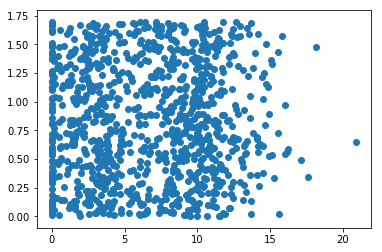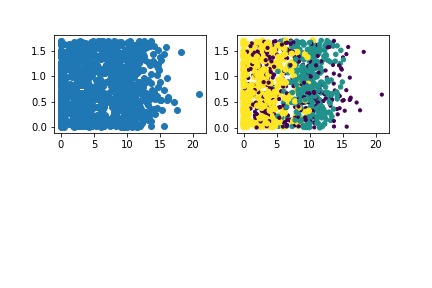datingTestSet.txt: 是一个4列的文本文件,其中前三列是features 最后一列是labels
目标: 将该文本文件分离成 x,y 其中 x 为 含有features 的 matrix y 为仅含有labels 的 list
import numpy as np
def file2matrix(filename):
fr=open(filename)
numberoflines=len(fr.readlines())
y=[]
x=np.zeros([numberoflines,3])
index=0
fr=open(filename)
for lines in fr.readlines():
data=[]
lines=lines.strip()
data=lines.split('\t')
x[index,:]=data[0:3]
index=index+1
y.append(data[-1])
return x,y
【结果:】
y:
'didntLike', 'smallDoses', 'smallDoses', 'smallDoses', 'largeDoses', 'smallDoses', 'didntLike', 'largeDoses', 'smallDoses', 'largeDoses', 'smallDoses', 'largeDoses', 'smallDoses',
x:
array([[ 4.09200000e+04, 8.32697600e+00, 9.53952000e-01],
[ 1.44880000e+04, 7.15346900e+00, 1.67390400e+00],
[ 2.60520000e+04, 1.44187100e+00, 8.05124000e-01],
...,
[ 2.65750000e+04, 1.06501020e+01, 8.66627000e-01],
[ 4.81110000e+04, 9.13452800e+00, 7.28045000e-01],
[ 4.37570000e+04, 7.88260100e+00, 1.33244600e+00]])
【tips】
matrix: 只能是二维的
array: 不只是二维
【features 的类别:】
categorical features: comes from unordered sets: e.g. job city
numerical features: comes from ordered sets: e.g. age rates
将 categorical features 转成 numerical features: 用数字代替
e.g. 香蕉 苹果 梨子
1 2 3
01 10 11
001 010 100
转换:
import numpy as np
def file2matrix(filename):
fr=open(filename)
numberoflines=len(fr.readlines())
y=[]
stry=[]
x=np.zeros([numberoflines,3])
index=0
fr=open(filename)
for lines in fr.readlines():
#data=[]
lines=lines.strip()
data=lines.split('\t')
x[index,:]=data[0:3]
index=index+1
stry.append(data[-1])
# turn the categorical features to numerical features:
typeoflabels=np.unique(stry)
count=typeoflabels.shape[0]
for labels in stry:
if labels==typeoflabels[0]:
y.append(1)
elif labels==typeoflabels[1]:
y.append(2)
else:
y.append(3)
return x,y
【结果--y】
1, 3, 3, 3, 2, 3, 1, 2, 3, 2, 3, 2, 3, 1, 1,
***********************************
***********************************
***********************************
import matplotlib import matplotlib.pyplot as plt fig=plt.figure() ax=fig.add_subplot(111) ax.scatter(x[:,1],x[:,2]) plt.show()
扫描二维码关注公众号,回复:
656148 查看本文章


结果图:

【按照labes的分类给散点图上色】
import numpy as np
import matplotlib
import matplotlib.pyplot as plt
plt.figure()
plt.subplot(221)
plt.scatter(x[:,1],x[:,2])
plt.subplot(222)
y=np.array(y)
plt.scatter(x[:,1],x[:,2],10*y,10*y)
plt.savefig("scatterimage.png") # call savefig before call show
plt.show()
【结果图】

*********************************************************************************************************
【random forest】
import numpy as np
from sklearn.cross_validation import train_test_split
from sklearn.datasets import load_iris
from sklearn.ensemble import RandomForestClassifier
iris = load_iris()
n, d = iris.data.shape
X_train, X_test, y_train, y_test = train_test_split(iris.data, iris.target, test_size=0.3)
clf=RandomForestClassifier(n_estimators=100)
model2 =clf.fit(X_train,y_train)
y_pred = model2.predict(X_train)
train_error = np.mean(y_pred != y_train)
print("train error is %f" % train_error)
y_pred_test=model2.predict(X_test)
test_error=np.mean(y_pred_test != y_test)
print("test error is %f" % test_error)【测试结果】
train error is 0.000000 test error is 0.022222